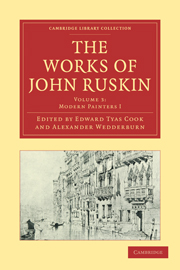Book contents
- Frontmatter
- Contents
- LIST OF ILLUSTRATIONS
- INTRODUCTION TO THIS VOLUME
- BIBLIOGRAPHICAL NOTE
- MODERN PAINTERS VOLUME I
- AUTHOR'S PREFACE TO FIRST EDITION (1843)
- AUTHOR'S PREFACE TO SECOND EDITION (1844)
- AUTHOR'S PREFACE TO THIRD EDITION (1846)
- AUTHOR'S PREFACE TO NEW EDITION (1873)
- AUTHOR'S SYNOPSIS OF CONTENTS
- PART I OF GENERAL PRINCIPLES
- SECTION I OF THE NATURE OF THE IDEAS CONVEYABLE BY ART
- CHAPTER 1 INTRODUCTORY
- CHAPTER II DEFINITION OF GREATNESS IN ART
- CHAPTER III OF IDEAS OF POWER
- CHAPTER IV OF IDEAS OF IMITATION
- CHAPTER V OF IDEAS OF TRUTH
- CHAPTER VI OF IDEAS OF BEAUTY
- CHAPTER VII OF IDEAS OF RELATION
- SECTION II OF POWER
- PART II OF TRUTH
- SECTION I GENERAL PRINCIPLES RESPECTING IDEAS OF TRUTH
- SECTION II OF GENERAL TRUTHS
- SECTION III OF TRUTH OF SKIES
- SECTION IV OF TRUTH OF EARTH
- SECTION V OF TRUTH OF WATER
- SECTION VI OF TRUTH OF VEGETATION.—CONCLUSION
- Appendix
- Plate section
CHAPTER V - OF IDEAS OF TRUTH
Published online by Cambridge University Press: 07 September 2011
- Frontmatter
- Contents
- LIST OF ILLUSTRATIONS
- INTRODUCTION TO THIS VOLUME
- BIBLIOGRAPHICAL NOTE
- MODERN PAINTERS VOLUME I
- AUTHOR'S PREFACE TO FIRST EDITION (1843)
- AUTHOR'S PREFACE TO SECOND EDITION (1844)
- AUTHOR'S PREFACE TO THIRD EDITION (1846)
- AUTHOR'S PREFACE TO NEW EDITION (1873)
- AUTHOR'S SYNOPSIS OF CONTENTS
- PART I OF GENERAL PRINCIPLES
- SECTION I OF THE NATURE OF THE IDEAS CONVEYABLE BY ART
- CHAPTER 1 INTRODUCTORY
- CHAPTER II DEFINITION OF GREATNESS IN ART
- CHAPTER III OF IDEAS OF POWER
- CHAPTER IV OF IDEAS OF IMITATION
- CHAPTER V OF IDEAS OF TRUTH
- CHAPTER VI OF IDEAS OF BEAUTY
- CHAPTER VII OF IDEAS OF RELATION
- SECTION II OF POWER
- PART II OF TRUTH
- SECTION I GENERAL PRINCIPLES RESPECTING IDEAS OF TRUTH
- SECTION II OF GENERAL TRUTHS
- SECTION III OF TRUTH OF SKIES
- SECTION IV OF TRUTH OF EARTH
- SECTION V OF TRUTH OF WATER
- SECTION VI OF TRUTH OF VEGETATION.—CONCLUSION
- Appendix
- Plate section
Summary
Meaning of the word “truth” as applied to art.
The word Truth, as applied to art, signifies the faithful state ment, either to the mind or senses, of any fact of nature.
We receive an idea of truth, then, when we perceive the faithfulness of such a statement.
The difference between ideas of truth and of imitation lies chiefly in the following points:
First difference between truth and imitation
First,—Imitation can only be of something material, but truth has reference to statements both of the qualities of material things, and of emotions, impressions, and thoughts. There is a moral as well as material truth,—a truth of impression as well as of form,—of thought as well as of matter; and the truth of impression and thought is a thousand times the more important of the two. Hence, truth is a term of universal application, but imitation is limited to that narrow field of art which takes cognizance only of material things.
Secondly,—Truth may be stated by any signs or symbols which have a definite signification in the minds those to whom they are addressed, although such signs be themselves no image nor likeness of anything. Whatever can excite in the mind the conception of certain facts, can give ideas of truth, though it be in no degree the imitation or resemblance of those facts.
- Type
- Chapter
- Information
- The Works of John Ruskin , pp. 104 - 108Publisher: Cambridge University PressPrint publication year: 2010First published in: 1903

